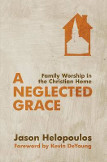
Was Jesus Still God in the Tomb?
Was Jesus God in the womb? Was Jesus God in the tomb? You probably answered
Reason looks at the almost invisible fetus, that Jesus became in the womb of the virgin, and says, “God cannot become a microscopic collection of cells.” Then faith says, “I believe, help my unbelief,” and worships. But when our eye looks at that lifeless body in a cold garden tomb, now dead for over 48 hours, and we’re asked to bow in worship, we exclaim, “I don’t believe, help my unbelief,” and refuse to worship.
Yes, it was right to worship Jesus as God in the womb, in the manger, on the breast, at play, in school, in the workshop, in the court, and on the cross; but in the tomb? Surely not. Jesus was in heaven for these few days, His human soul still united to His divine nature, rightly being worshipped there for His saving work of suffering and dying for sinners. Yes, that worship is theologically sound and totally appropriate. But was Jesus not also on a cold slab of rock in a Middle Eastern cave? Yes, He was. While His human soul was separated from His body, His divine nature was separated from neither and never will be. His divine nature was as united to His lifeless body on earth as it was to His glorified soul in heaven. That means I can worship Him equally in the grave as in glory!
Do you doubt that? Try some confessional standards for size. Shorter Catechism answer 21 says:
The only redeemer of God's elect is the Lord Jesus Christ, who, being the eternal Son of God, became man, and so was, and continueth to be, God and man in two distinct natures, and one person, forever.
The Westminster Confession of Faith, chapter 7.2, says that the “two whole, perfect, and distinct natures, the Godhead and the manhood, were inseparably joined together in one person.”
Christ’s body and soul, His manhood, were inseparably joined together to the divine person of Christ. Therefore if I had walked into the garden tomb and gazed on Christ’s outstretched body, I not only could have, but should have, fallen to the ground and said, “My Lord and my God.” That dead body was still God and therefore deserving of worship. In fact, could it be argued that He was never more worthy of worship? What willing humiliation for my salvation!
Why not, by faith, take a walk into that tomb, “see” your Savior lying there, and bow in humble adoration. And while you’re there, why not sing Psalm 16 which prophesied this very moment in Christ’s experience (study Psalm 16 in light of Pater's inspired exposition of it Acts 2:25-31):
Therefore my heart is glad, and my glory rejoices;
My flesh also will rest in hope.
For You will not leave my soul in Sheol,
Nor will You allow Your Holy One to see corruption.
You will show me the path of life;
In Your presence is fullness of joy;
At Your right hand are pleasures forevermore.
UPDATE:
Since writing this post, Danny Hyde passed along an even more clear supporting statement from Belgic Confession, Article 19, where we read: "So then what he committed to his Father when he died was a real human spirit which left his body. But meanwhile his divine nature remained united with his human nature even when he was lying in the grave; and his deity never ceased to be in him, just as it was in him when he was a little child, though for a while it did not show itself as such."



















 © Alliance of Confessing Evangelicals
© Alliance of Confessing Evangelicals


